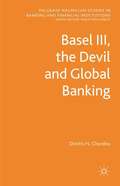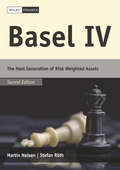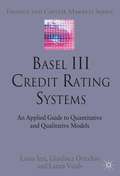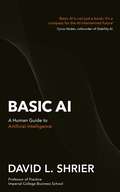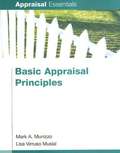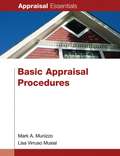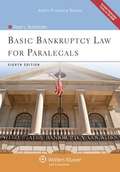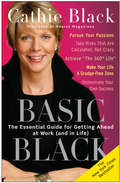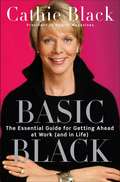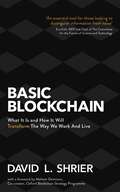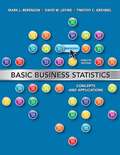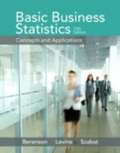- Table View
- List View
Basel II: Assessing the Default and Loss Characteristics of Project Finance Loans (B)
by Aldo Sesia Benjamin C. EstySupplements the (A) case.
Basel III in der Unternehmenspraxis: Strategien Zur Bewältigung Erhöhter Bonitätsanforderungen (essentials)
by Bernd Zirkler Jonathan Hofmann Sandra SchmolzBernd Zirkler, Jonathan Hofmann und Sandra Schmolz geben einen praxisbezogenen Überblick über die wesentlichen Inhalte und Anforderungen der Kapital- und Liquiditätsvorschriften von Basel III und deren schrittweise Einführung bis 2019. Die Autoren zeigen die direkten Auswirkungen der Regelungen von Basel III auf die Kreditinstitute und die Ergebnisse der in diesem Zusammenhang durchgeführten Auswirkungsstudien auf.
Basel III, the Devil and Global Banking
by Dimitris N. ChorafasThe banking industry extensively lobbied against Basel III and governments have been keen to delay its full implementation. Chorafas' latest book takes a well-rounded approach on Basel III's strengths and weaknesses and explains how, without deep restructuring of the global banking industry, (like Basel II) Basel III will fail.
Basel IV in der Unternehmenspraxis (essentials)
by Bernd Zirkler Jonathan Hofmann Sandra Schmolz Ilona BordiyanuBernd Zirkler, Jonathan Hofmann, Sandra Schmolz und Ilona Bordiyanu geben im vorliegenden Buch einen praxisbezogenen Überblick zum finalisierten Rahmenwerk von Basel III (alternativ als ‚Basel IV‘ bezeichnet). Es erläutert überblicksartig zu erwartende Auswirkungen auf Kreditinstitute hinsichtlich wesentlicher regulatorischer Anforderungen. Hierbei werden insbesondere die risikogewichteten Kapitalanforderungen, bestehende Höchstverschuldungsgrenzen, Liquiditätsvorschriften, Risikomanagement/bankaufsichtlicher Überprüfungsprozess sowie Marktdisziplin/Offenlegung von ‚Basel IV‘ im Rahmen ihrer schrittweisen Einführung bis 2028 dargestellt.
Basel IV: The Next Generation of Risk Weighted Assets
by Stefan Roth Martin NeisenIn December 2017 the Basel committee finalised its work on the reform of the Basel III framework. Together with requirements already published in 2015 and 2016, the Basel committee changes all approaches for the calculation of RWA and the corresponding Pillar III disclosure rules. This package of new standards from the Basel Committee, which is unofficially called "Basel IV", is now the most comprehensive package of modifications in the history of banking supervision. The banking industry will face major challenges in implementing these new rules. The second edition of the "Basel IV" handbook is updated with all publications up to March 2018 and also extensively enhanced with additional details, examples and case studies. The aim is to convince the reader that we are facing a new framework called "Basel IV" and not just a fine adjustment of the existing Basel III regulations. This book covers all new approaches for the calculation of RWA: - the standardised approach (CR-SA) and the IRB approach for credit risk, - the new standardised approach for counterparty credit risk (SA-CCR), - both the standardised approach and internal models approach from the "fundamental review of the trading book" (SBA and IMA) - the basic approach (BA-CVA) and standardised approach (SA-CVA) for the CVA risk, - all new approaches (SEC-IRBA, SEC-ERBA, SEC-SA, IAA) for securitisations (incl. STS), - the approaches for the calculation of RWA for equity positions in investment funds (LTA, MBA, FBA) - the new standardised approach for operational risk (SA-OpRisk) Because of the strong relation to the Pillar I requirements, the second edition covers the topics of interest rate risk in the banking book (IRRBB), large exposures and TLAC again. Additionally, the book contains a detailed description of the Pillar III disclosure requirements. With the aid of a high-profile team of experts from countries all over the globe, the complexity of the topic is reduced, and important support is offered.
Basel Iii Credit Rating Systems
by Laura Vitale Gianluca Oricchio Luisa IzziThe market turmoil and the new Basel III capital requirements are re-shaping the financial competitive landscape. More than ever, banking competition is based on the ability to assess, to price and to manage the cost of credit risk. Bankers are increasingly called to manage a process of analysis of the customer in a more structured way. This book is a comprehensive guide to quantitative and qualitative credit rating models and covers all loan portfolios (Corporate, Retail, Banks, Sovereign and Specialized Lending). The credit rating models are illustrated in great detail and are based on the best practices currently in use in large international banking groups. The book also contains pricing tools for liquid and non-liquid markets and is one of the first books on credit risk management published since the crisis.
Baseline: Confronting Reality and Planning the Path for Success (BASICS Lean® Implementation)
by Charles Protzman Fred Whiton Joyce KerpcharLean is about building and improving stable and predictable systems and processes to deliver to customers high-quality products/services on time by engaging everyone in the organization. Combined with this, organizations need to create an environment of respect for people and continuous learning. It’s all about people. People create the product or service, drive innovation, and create systems and processes, and with leadership buy-in and accountability to ensure sustainment with this philosophy, employees will be committed to the organization as they learn and grow personally and professionally. Lean is a term that describes a way of thinking about and managing companies as an enterprise. Becoming Lean requires the following: the continual pursuit to identify and eliminate waste; the establishment of efficient flow of both information and process; and an unwavering top-level commitment. The concept of continuous improvement applies to any process in any industry. Based on the contents of The Lean Practitioners Field Book, the purpose of this series is to show, in detail, how any process can be improved utilizing a combination of tasks and people tools and introduces the BASICS Lean® concept. The books are designed for all levels of Lean practitioners and introduces proven tools for analysis and implementation that go beyond the traditional point kaizen event. Each book can be used as a stand-alone volume or used in combination with other titles based on specific needs. Each book is chock-full of case studies and stories from the authors’ own experiences in training organizations that have started or are continuing their Lean journey of continuous improvement. Contents include valuable lessons learned and each chapter concludes with questions pertaining to the focus of the chapter. Numerous photographs enrich and illustrate specific tools used in Lean methodology. Baseline: Confronting Reality & Planning the Path for Success focuses on change management and how to manage and accelerate change. The authors also outline how to get ready to implement lean, how to baseline your processes prior to implementing Lean, and how to create a value stream map of processes. This book also discusses Lean accounting and accounting for Lean.
Basic AI: A Human Guide to Artificial Intelligence
by David ShrierIn Basic AI, leading futurist David L. Shrier delves deep into the rapidly advancing world of artificial intelligence, delivering fascinating insights and exploring the impact this powerful technology will have on our lives and world.Artificial intelligence is driving workforce disruption on a scale not seen since the Industrial Revolution. In schools and universities, AI technology has forced a re-evaluation of the way students are taught and assessed. Meanwhile ChatGPT has become a cultural phenomenon, reaching 100 million users and attracting a $10 billion dollar investment in its parent company OpenAI. The race to dominate the generative AI market is accelerating at breakneck speed, inspiring breathless headlines and immense public interest.Basic AI provides a rare window into a frontier area of computer science that will change everything about how you live and work. Listen to this book and better understand how to succeed in the AI-enabled future.
Basic AI: A Human Guide to Artificial Intelligence
by David ShrierIn Basic AI, leading futurist David L. Shrier delves deep into the rapidly advancing world of artificial intelligence, delivering fascinating insights and exploring the impact this powerful technology will have on our lives and world.Artificial intelligence is driving workforce disruption on a scale not seen since the Industrial Revolution. In schools and universities, AI technology has forced a re-evaluation of the way students are taught and assessed. Meanwhile ChatGPT has become a cultural phenomenon, reaching 100 million users and attracting a $10 billion dollar investment in its parent company OpenAI. The race to dominate the generative AI market is accelerating at breakneck speed, inspiring breathless headlines and immense public interest.Basic AI provides a rare window into a frontier area of computer science that will change everything about how you live and work. Read this book and better understand how to succeed in the AI-enabled future.
Basic Accounting: Teach Yourself
by Randall J. Stott Mike TrumanBasic Accounting is a complete, step-by-step course in elementary accounting. Giving clear and concise explanations of accounting principles and practice including PAYE, cashflow statements, accounting for share capital, accounting standards and non-financial reporting, it is perfect for the newcomer to basic accounting, the first- level accounting student or anybody needing to brush up their accounting skills. No prior knowledge of bookkeeping or accounting is assumed. Clear explanations, diagrams and worked examples enable you to master the basic principles then apply them to practical examples to consolidate and test your knowledge. NOT GOT MUCH TIME? One, five and ten-minute introductions to key principles to get you started. AUTHOR INSIGHTS Lots of instant help with common problems and quick tips for success, based on the authors' many years of experience. TEST YOURSELF Tests in the book and online to keep track of your progress. EXTEND YOUR KNOWLEDGE Extra online articles at www.teachyourself.com to give you a richer understanding of accounting. TRY THIS Innovative exercises illustrate what you've learnt and how to use it.
Basic Accounting: The step-by-step course in elementary accountancy
by Andy Lymer Nishat AzmatIs this the right book for me?Basic Accounting is a complete, step-by-step course in elementary accounting. Giving clear and concise explanations of accounting principles and practice including PAYE, cashflow statements, accounting for share capital, accounting standards and non-financial reporting, it is perfect for the newcomer to basic accounting, the first- level accounting student or anybody needing to brush up their accounting skills.No prior knowledge of bookkeeping or accounting is assumed. Clear explanations, diagrams and worked examples enable you to master the basic principles then apply them to practical examples to consolidate and test your knowledge.Basic Accounting includes:Chapter 1: IntroductionChapter 2: Source documentsChapter 3: The ledger systemChapter 4: Balancing the cash bookChapter 5: Double entry theory and practiceChapter 6: The trial balanceChapter 7: Gross profit and stockChapter 8: Trading and profit and loss and accountsChapter 9: The balance sheetChapter 10: Illustrative exampleChapter 11: Cash and bank transactionsChapter 12: Bank reconciliationChapter 13: The petty cash bookChapter 14: Credit transactions and suppliers' accountsChapter 15: The accounts of credit customersChapter 16: Purchases and sales returnsChapter 17: VAT and PAYEChapter 18: Classification of ledger accountsChapter 19: Final accounts of a sole traderChapter 20: Interpretation of accountsChapter 21: Cash flow statementsChapter 22: Capital and revenue expenditureChapter 23: The genera; journalChapter 24: Depreciation of fixed assetsChapter 25: Bad debts and provision for bad debtsChapter 26: Year-end adjustmentsChapter 27: Incomplete records and single entryChapter 28: Non-trading concerns and club accountsChapter 29: Control AccountsChapter 30: Partnership accountsChapter 31: Accounting for managementChapter 32: Costs of production and manufacturing accountsChapter 33: Introduction to limited companiesChapter 34: Accounting for share capitalChapter 35: The final accounts of a limited companyChapter 36: Accounting standardsChapter 37: Non-financial reportingChapter 38: Computerized accountingLearn effortlessly with easy-to-read page design and interactive features:Not got much time?One, five and ten-minute introductions to key principles to get you started.Author insightsLots of instant help with common problems and quick tips for success, based on the authors' many years of experience.Test yourselfTests in the book and online to keep track of your progress.Extend your knowledgeExtra online articles to give you a richer understanding of accounting.Try thisInnovative exercises illustrate what you've learnt and how to use it.
Basic Accounting: The step-by-step course in elementary accountancy
by Andy Lymer Nishat AzmatIs this the right book for me?Basic Accounting is a complete, step-by-step course in elementary accounting. Giving clear and concise explanations of accounting principles and practice including PAYE, cashflow statements, accounting for share capital, accounting standards and non-financial reporting, it is perfect for the newcomer to basic accounting, the first- level accounting student or anybody needing to brush up their accounting skills.No prior knowledge of bookkeeping or accounting is assumed. Clear explanations, diagrams and worked examples enable you to master the basic principles then apply them to practical examples to consolidate and test your knowledge.Basic Accounting includes:Chapter 1: IntroductionChapter 2: Source documentsChapter 3: The ledger systemChapter 4: Balancing the cash bookChapter 5: Double entry theory and practiceChapter 6: The trial balanceChapter 7: Gross profit and stockChapter 8: Trading and profit and loss and accountsChapter 9: The balance sheetChapter 10: Illustrative exampleChapter 11: Cash and bank transactionsChapter 12: Bank reconciliationChapter 13: The petty cash bookChapter 14: Credit transactions and suppliers' accountsChapter 15: The accounts of credit customersChapter 16: Purchases and sales returnsChapter 17: VAT and PAYEChapter 18: Classification of ledger accountsChapter 19: Final accounts of a sole traderChapter 20: Interpretation of accountsChapter 21: Cash flow statementsChapter 22: Capital and revenue expenditureChapter 23: The genera; journalChapter 24: Depreciation of fixed assetsChapter 25: Bad debts and provision for bad debtsChapter 26: Year-end adjustmentsChapter 27: Incomplete records and single entryChapter 28: Non-trading concerns and club accountsChapter 29: Control AccountsChapter 30: Partnership accountsChapter 31: Accounting for managementChapter 32: Costs of production and manufacturing accountsChapter 33: Introduction to limited companiesChapter 34: Accounting for share capitalChapter 35: The final accounts of a limited companyChapter 36: Accounting standardsChapter 37: Non-financial reportingChapter 38: Computerized accountingLearn effortlessly with easy-to-read page design and interactive features:Not got much time?One, five and ten-minute introductions to key principles to get you started.Author insightsLots of instant help with common problems and quick tips for success, based on the authors' many years of experience.Test yourselfTests in the book and online to keep track of your progress.Extend your knowledgeExtra online articles to give you a richer understanding of accounting.Try thisInnovative exercises illustrate what you've learnt and how to use it.
Basic Appraisal Principles
by Mark A. Munizzo Lisa Virruso MusialThis 30-hour text is designed to be used with Basic Appraisal Procedures to meet the suggested first 60 hours of core content for appraisal trainees under the 2008 AQB Criteria.
Basic Appraisal Procedures
by Mark A. Munizzo Lisa Virruso MusialProcedures used in appraising residential and commercial real estate.
Basic Attending Skills: Foundations of Empathic Relationships and Problem Solving
by Mary Bradford Ivey Allen Ivey Norma Gluckstern PackardIn Basic Attending Skills: Foundations of Empathic Relationships and Problem Solving, students learn and master the fundamental skills of listening, including attending behavior, questions, encouragers, paraphrasing, reflection of feelings, and summarization through a straightforward, step-by-step process. Readers discover how the essential skills of listening and interviewing are critical for counseling, psychotherapy, and meaningful interpersonal communication. <p><P> Over the course of eight chapters, students review basic attending skills, effective listening strategies, the community genogram, emotional regulation, and more. They learn how to leverage and apply only listening skills to complete a well-structured interview with a client that is effective, adapted to the individual, and incorporates multicultural practice. The integration of a client’s behavior, thoughts, and feelings into effective treatment is also addressed. <p><P> The sixth edition includes in-depth explanation of why the community genogram is useful and how to incorporate it into an interview; a deeper focus on strengths, resiliency, and the positive asset search; and information of neuroscience, its relationship to counseling, and what practitioners need to know about the brain to work more effectively with clients. <p><P> A foundational guide for effective practice, Basic Attending Skills is well suited for introductory courses in counseling.
Basic Bankruptcy Law for Paralegals (8th Edition)
by David L. BuchbinderBasic Bankruptcy Law for Paralegals focuses on what paralegals need to know to be effective paralegals in a bankruptcy practice. Comprehensive yet accessible, this proven-effective text offers a step-by-step overview of the bankruptcy code and rules. With a consistent emphasis on practice, David Buchbinder vividly describes the role of the paralegal at every stage of a bankruptcy proceeding, providing practical information along the way. A wealth of examples, checklists, and summaries put bankruptcy law squarely within reach. This text is available in ebook format from the Vital Source Store . To download and use the ebook, you will need the free Vital Source Bookshelf software. DOWNLOAD NOW Thoroughly updated, the Eighth Edition includes new Supreme Court cases that interpret bankruptcy law and recent changes to the Federal Rules of Bankruptcy Procedure. a favorite among paralegal instructors, Basic Bankruptcy Law for Paralegals features:a clear and readable writing style designed to let students learn and digest the basics complete coverage of everything a student needs to know to become a competent bankruptcy paralegal --consumer representation, creditor representation, and assisting with a Chapter 11 case a useful overview of the bankruptcy code and rules that sheds light on the role of the paralegal at every stage of a bankruptcy proceeding practical information about how and when to complete bankruptcy documents a rich variety of learning and memory aids, such as examples,checklists of procedures, summaries of the law, and discussion questions a Forms Manual on CD-ROM a generous teaching package, including a detailed Instructor's Manual, Test Bank, PowerPoints, and Best Case Exercises Updated throughout, the Eighth Edition of Basic Bankruptcy Law for Paralegals includes: recent case rulings interpreting bankruptcy law developments and changes in the Federal Rules of Bankruptcy Procedure *Instructor's Manuals are a professional courtesy offered to professors only. For more information or to request a copy, please contact Wolter's Kluwer Law & Business at 800.529.7545 or examcopy@wolterskluwer.com.
Basic Black
by Cathie BlackCathie Black is the wise, funny mentor that every woman dreams of having. She was a pioneer in advertising sales at a time when women didn't sell; served as president and publisher of the fledgling USA Today; and, in her current position as the president of Hearst Magazines, persuaded Oprah to launch a magazine. In 2006 she was named one of Fortune's "50 Most Powerful Women in American Business" for the seventh consecutive year. Now, in the exuberant, down-to-earth voice that is her trademark, Cathie explains how she achieved "the 360° life"--a blend of professional accomplishment and personal contentment--and how any woman can seize opportunity in the workplace. No matter where you are in your career, Basic Black offers invaluable lessons that will help you land the job, promotion, or project you're vying for. At the core of the book are Cathie's candid, personal stories. She walks us through her decision to risk dropping a huge ad agency that handled the USA Today campaign in favor of a small boutique agency run by a wild man. (It was a smash.) She admits that her sometimes brusque style once led to a mutiny of staffers at Ms. (She learned to be more flexible in her managerial style.) She offers a clear-eyed look at what happened during the twenty-eight months between the launch and the close of the much-buzzed-about Talk magazine. And throughout, she offers fascinating glimpses of media and business personalities, such as Rupert Murdoch, Tina Brown, Frank Bennack, Vic Ganzi, former Cosmo Girl! editor Atoosa Rubenstein, Bonnie Fuller, and the legendarily difficult Al Neuharth, founder of USA Today. Above all,Basic Black is motivating. It provides a close-up look at the keen judgment, perseverance, and optimism that have propelled Cathie Black to the top of her game, along with the kind of straight-up practical advice you get in a one-on-one session with a career coach. You'll find out how to handle job interviews, which rules to break, and why you should make your life a grudge-free zone. Equally important, you'll be inspired to pursue your passions and achieve your very best.
Basic Black: The Essential Guide for Getting Ahead at Work (and in Life)
by Cathie BlackCathie Black is the wise, funny mentor that every woman dreams of having. She was a pioneer in advertising sales at a time when women didn't sell; served as president and publisher of the fledgling "USA Today"; and, in her current position as the president of Hearst Magazines, persuaded Oprah to launch a magazine.<P> In 2006 she was named one of Fortune's "50 Most Powerful Women in American Business" for the seventh consecutive year. Now, in the exuberant, down-to-earth voice that is her trademark, Cathie explains how she achieved "the 360 degree life"--a blend of professional accomplishment and personal contentment--and how any woman can seize opportunity in the workplace.<P> No matter where you are in your career, "Basic Black" offers invaluable lessons that will help you land the job, promotion, or project you're vying for. At the core of the book are Cathie's candid, personal stories. She walks us through her decision to risk dropping a huge ad agency that handled the "USA Today" campaign in favor of a small boutique agency run by a wild man. (It was a smash.) She admits that her sometimes brusque style once led to a mutiny of staffers at Ms. (She learned to be more flexible in her managerial style.) She offers a clear-eyed look at what happened during the twenty-eight months between the launch and the close of the much-buzzed-about "Talk" magazine. And throughout, she offers fascinating glimpses of media and business personalities, such as Rupert Murdoch, Tina Brown, Frank Bennack, Vic Ganzi, former "CosmoGirl!" editor Atoosa Rubenstein, Bonnie Fuller, and the legendarily difficult Al Neuharth, founder of "USA Today".<P> Above all, "Basic Black" is motivating. It provides a close-up look at the keen judgment, perseverance, and optimism that have propelled Cathie Black to the top of her game, along with the kind of straight-up practical advice you get in a one-on-one session with a career coach. You'll find out how to handle job interviews, which rules to break, and why you should make your life a grudge-free zone. Equally important, you'll be inspired to pursue your passions and achieve your very best.
Basic Blockchain: What It Is and How It Will Transform the Way We Work and Live
by David ShrierThe only book you need to understand blockchain: what it is, how it works and how it will transform business, society and our everyday lives. Basic Blockchain is an accessible, non-technical introduction to a revolutionary technology.'Makes it easy for the average business executive to understand blockchain' -- Chris Larsen, founder and chairman, Ripple'An essential tool for those looking to distinguish information from noise' -- Eva Kaili, MEP and Chair of The Committee for the Future of Science and TechnologyA revolution is under way across the globe, yet very few people understand it. Basic Blockchain will explain everything you need to know to understand the technology that will soon disrupt and revolutionise everything from financial and health services to the property market and how we vote.Born of an obscure body of research on game theory developed by NASA, originally championed by drug dealers seeking to launder ill-gotten gains, accelerated by entrepreneurs seeking to improve financial access for the poor, funded by giant corporate interests attracted to the potential for billions of dollars of cost savings, blockchain heralds a new era of financial inclusion, legal inclusion for the dispossessed and lower prices for consumers. In short, it will enact radical change on our lives.In this book, David L. Shrier, one of MIT and Oxford University's leading futurists, explains for the general reader:- The history of blockchain, its apocryphal progenitor Satoshi Nakamoto and the socioeconomic context of its origins in the 2008 financial crisis.- How blockchain works, including the core technologies that drive it such as cryptographic hashes and network theory, all described in simple, understandable terms.- The potential of blockchain, including its impact on our jobs, industry and society as a whole. Blockchain will disrupt and transform our world in profound ways. This accessible book, written by a global authority on blockchain, is the essential introduction to the next technological revolution.
Basic Blockchain: What It Is and How It Will Transform the Way We Work and Live
by David ShrierThe only book you need to understand blockchain: what it is, how it works and how it will transform business, society and our everyday lives. Basic Blockchain is an accessible, non-technical introduction to a revolutionary technology.'Makes it easy for the average business executive to understand blockchain' -- Chris Larsen, founder and chairman, Ripple'An essential tool for those looking to distinguish information from noise' -- Eva Kaili, MEP and Chair of The Committee for the Future of Science and TechnologyA revolution is under way across the globe, yet very few people understand it. Basic Blockchain will explain everything you need to know to understand the technology that will soon disrupt and revolutionise everything from financial and health services to the property market and how we vote.Born of an obscure body of research on game theory developed by NASA, originally championed by drug dealers seeking to launder ill-gotten gains, accelerated by entrepreneurs seeking to improve financial access for the poor, funded by giant corporate interests attracted to the potential for billions of dollars of cost savings, blockchain heralds a new era of financial inclusion, legal inclusion for the dispossessed and lower prices for consumers. In short, it will enact radical change on our lives.In this book, David L. Shrier, one of MIT and Oxford University's leading futurists, explains for the general reader:- The history of blockchain, its apocryphal progenitor Satoshi Nakamoto and the socioeconomic context of its origins in the 2008 financial crisis.- How blockchain works, including the core technologies that drive it such as cryptographic hashes and network theory, all described in simple, understandable terms.- The potential of blockchain, including its impact on our jobs, industry and society as a whole. Blockchain will disrupt and transform our world in profound ways. This accessible book, written by a global authority on blockchain, is the essential introduction to the next technological revolution.
Basic Blockchain: What It Is and How It Will Transform the Way We Work and Live
by David ShrierThe only book you need to understand blockchain: what it is, how it works and how it will transform business, society and our everyday lives. Basic Blockchain is an accessible, non-technical introduction to a revolutionary technology.'Makes it easy for the average business executive to understand blockchain' -- Chris Larsen, founder and chairman, Ripple'An essential tool for those looking to distinguish information from noise' -- Eva Kaili, MEP and Chair of The Committee for the Future of Science and TechnologyA revolution is under way across the globe, yet very few people understand it. Basic Blockchain will explain everything you need to know to understand the technology that will soon disrupt and revolutionise everything from financial and health services to the property market and how we vote.Born of an obscure body of research on game theory developed by NASA, originally championed by drug dealers seeking to launder ill-gotten gains, accelerated by entrepreneurs seeking to improve financial access for the poor, funded by giant corporate interests attracted to the potential for billions of dollars of cost savings, blockchain heralds a new era of financial inclusion, legal inclusion for the dispossessed and lower prices for consumers. In short, it will enact radical change on our lives.In this book, David L. Shrier, one of MIT and Oxford University's leading futurists, explains for the general reader:- The history of blockchain, its apocryphal progenitor Satoshi Nakamoto and the socioeconomic context of its origins in the 2008 financial crisis.- How blockchain works, including the core technologies that drive it such as cryptographic hashes and network theory, all described in simple, understandable terms.- The potential of blockchain, including its impact on our jobs, industry and society as a whole. Blockchain will disrupt and transform our world in profound ways. This accessible book, written by a global authority on blockchain, is the essential introduction to the next technological revolution.
Basic Business Law
by James F. Morgan Peter J. Shedd Gerald Seals Robert N. CorleyThe chapters in Basic Business Law are made up of two basic parts: Text and problems. First, the text is written in a style designed for business students and students in related disciplines, introducing them to the legal issues they will face throughout their careers. Second, basic legal problems that confront business executives, including questions and factual scenarios, are included at the end of each chapter.
Basic Business Math: A Life-Skills Approach
by Richard P. TruchonTrust Crisp to take the misery out of math! This easy book covers whole numbers, fractions, decimals, percentages, simple equations, and percentage formulas with examples of: commissions, markups and markdowns, discounts, sales tax, simple and compound interest, and installment loans. Practice with bar, line and circle graphs, follow with just a touch of statistics-averages, medians, modes, etc. Answers included. It simply makes math work for anyone!
Basic Business Statistics
by Mark L. Berenson David M. Levine Timothy C. Krehbiel David F. StephanBerenson shows readers how statistics is used in each functional area of business. Basic Business Statistics shows the relevance of statistics by familiarizing readers with the statistical applications used in the business world, providing clear instructions for using statistical applications, and offering ample opportunities for practice. The twelfth edition has built on the application emphasis and provides enhanced coverage of statistics.
Basic Business Statistics: Concepts and Applications
by Mark L. Berenson David M. Levine Kathryn A. SzabatStatistics is essential for all business majors and this text helps students see the role statistics will play in their own careers by providing examples drawn from all functional areas of business. Guided by principles set by major statistical and business science associations (ASA and DSI), plus the authors' diverse teaching experiences, the Thirteenth Edition of Berenson/Levine/Szabat's Basic Business Statistics continues to innovate and improve the way this course is taught to all students.


